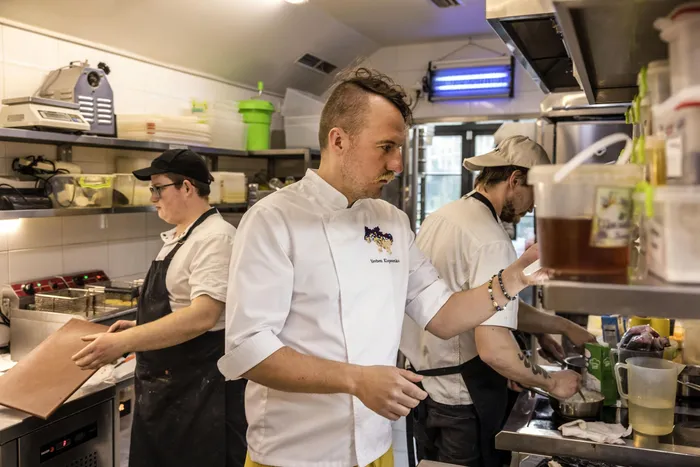
Klopotenko in the kitchen at Poltava.
Image: Oksana Parafeniuk for The Washington Post
Olga Massov
“Ready to cook?”
Standing behind the island in his studio kitchen, looking at me through the screen, Yevhen Klopotenko is getting ready to teach me how to make Ukrainian dumplings. The sun streams through his expansive windows; the space feels peaceful. If you were in my kitchen observing the Zoom, you’d never know that on the other end of this call is a war zone.
We’re separated by continents, miles and so much more. I’m safely ensconced in a Maryland suburb, while the Ukrainian chef and restaurateur is in Kyiv, living through another year of the war with Russia. We’re both surrounded by natural light, despite the seven-hour time difference.
I had originally planned to cook with Klopotenko in person when he was scheduled to be in the United States to promote his second English cookbook, “The Authentic Ukrainian Kitchen,” published last spring by Voracious. But since the Russian invasion, Ukrainian men between the ages of 18 and 60 have been forbidden from leaving the country due to martial law, and those 25 and older can be drafted. So we’re cooking virtually.
Klopotenko, 38, is tall and lanky, with a mop of curly hair and fingernails painted in blue and yellow, the colors of the Ukrainian flag. His gaze is sharp, with a twinkle of defiance. This is, after all, the man who in 2020 started the petition with UNESCO to recognize borshch as part of Ukrainian national heritage, and got his wish in 2022 - the same year Russia launched its brutal full-scale invasion of his country. As he writes in his cookbook introduction, his raison d’être is to improve the food culture in Ukraine and raise awareness of its culinary legacy.
Klopotenko had long understood borshch’s significance to the nation’s sense of self, as the dish is often mistaken for being Russian. But the public reaction when it won its UNESCO recognition still surprised even him. Millions of Ukrainians woke up one day eating just borshch, but when they went to sleep, they were eating “a world heritage dish. … It’s as if everyone had said, ‘We’re ready to invite you to be a part of the world.’ We were finally on the map,” he says.
It may not have been such a big deal if they hadn’t been told for so long that they didn’t even exist. But for a country living in the shadow of its much larger neighbor and fighting for independence, this was when Ukrainians realized that they had something no one could take from them.
The idea of authentic Ukrainian cuisine connected with Michael Szczerban, who oversees the Voracious and Spark imprints for Little, Brown and Company and who acquired and edited Klopotenko’s cookbook. Szczerban quickly realized that what he knew as Ukrainian food, the food his grandparents brought to the U.S. from western Ukraine, was the Soviet version. What Klopotenko was so excited to share were dishes Szczerban had never heard of.
Unlike authors of Ukrainian cookbooks written in the diaspora or as third-culture offerings, “he was from there,” Szczerban said. “He had grown up there, went to school there.” He was trying to bring Ukraine’s food into the future by honoring its past.
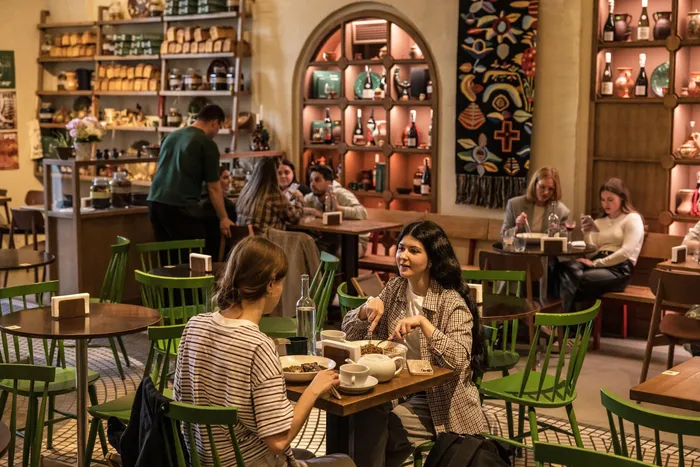
Visitors have a meal at Poltava.
Image: Oksana Parafeniuk for The Washington Post
Beyond borshch
When Klopotenko and I were planning what we’d cook together over Zoom, we decided against borshch, hoping to move the conversation about Ukrainian food beyond it.
At some point, while discussing halushky, dumplings popular across Eastern Europe, Klopotenko pointed out how many ways they can be made: filled or not, big or small, sweet or savory. We talked about how dumplings are a connecting thread among cultures, geographies and time. And that’s how we settled on making schipani halushky, which look like little gnocchi. Simple and unstuffed (schipani means pinched), they’re served with sour cherries and a generous helping of sour cream, often as a side to a meat dish.
Klopotenko and I are both fluent in Russian, but he prefers not to speak it, and because I don’t speak Ukrainian, our dumpling session and other interviews are in English - of which he has an excellent command.
While mixing the dough and forming the halushky, I ask questions: Is the dough too sticky? Should I roll out ropes and use a bench cutter to make pieces, or should I pinch them off?
He laughs when I tell him I raided the farmers market for all the sour cherries available. When his water comes to a boil much faster than mine, I apologize for slowing him down. I’m oddly nervous, even though I’ve been cooking my entire life: I want to make these dumplings exactly as he does, so readers have a truly Ukrainian recipe.
Once the dumplings and cherries are cooked, I spoon sour cream over everything. “More,” Klopotenko encourages me. “Keep going.”
The excess makes me feel like I’m with my people. There can never be too much sour cream.
When history gets rewritten
I’ve always felt a connection to Ukraine, despite having never visited. I grew up in St. Petersburg - then Leningrad, USSR. While my collective family background extends to the Austro-Hungarian Empire, Uzbekistan, Latvia and Russia, my paternal grandfather’s family grew up in the Poltava region of central Ukraine, which also happens to be the name of one of Klopotenko’s restaurants.
When I was a child, derogatory jokes about Ukrainians were commonplace: the bigoted perception of their provinciality against the Russian elite; the condescension toward those who dared to speak Ukrainian, or Russian with a Ukrainian accent - the telltale softening of a hard “g” sound. Szczerban told me about the term sharovarshchyna, from the word “sharovary,” which refers to the wide trousers that Cossacks used to wear. It’s an insulting way to cast Ukrainians as backward-thinking and folksy, rather than recognizing the contributions to farming that have made the country the breadbasket of the world.
At some point, as I got older and became more aware of the world, I learned how culture and identity can become appropriated by others and how history can be rewritten by those controlling the narrative. It took me a while to grasp the subtle manipulation, such as the Russification of Ukrainian city names (Kiev instead of Kyiv, Lvov instead of Lviv), and Ukrainian cuisine being folded into the monolith umbrella of Soviet cookery.
Klopotenko was born in 1986, the year of the Chernobyl nuclear disaster. He and his sister were part of a “typical USSR family,” he says, with a father who was an engineer and a mother who was a school administrator. After finishing high school, Klopotenko studied international relations at Kyiv University of Economics and Law, but his heart had been in cooking since childhood.
In 1991, the year Ukraine declared its independence, Klopotenko was almost 5 and his grandmother moved to the United Kingdom. As a child of Chernobyl-era Ukraine, Klopotenko was eligible to participate in a program that sent children abroad to improve their health, so he moved to Manchester for six months to live with her. (He spent a similar stretch of time in Italy the following two years.)
Living abroad opened Klopotenko’s world to many new foods and flavors - french fries, mozzarella cheese, fish sticks, spices he hadn’t tasted before - and ignited his interest in cooking. After Klopotenko returned to Ukraine, he found the dishes of his childhood, ghosts of the country’s Soviet past, bland and unappetizing. His palate - and his mind - had awakened. “You can have fresh salads without mayo,” he says with a laugh.
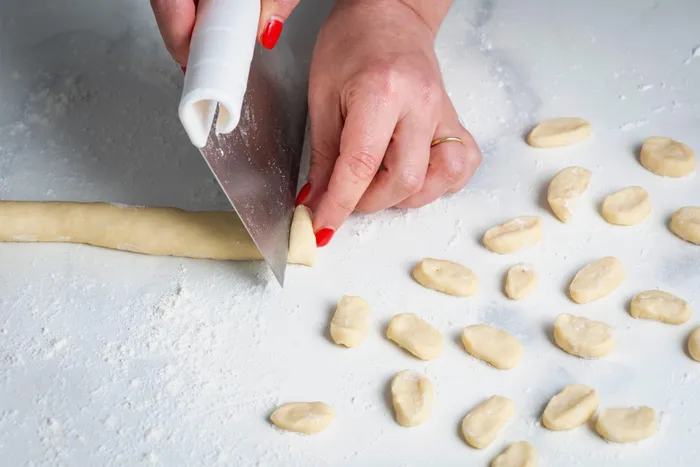
Cutting dumplings for Halushky With Sour Cherries.
Image: Oksana Parafeniuk for The Washington Post
Searching for a cuisine
Ukraine is the birthplace of Kievan Rus, the first East Slavic state that formed in the 9th century and out of which Russia, along with Ukraine and Belarus, eventually emerged. From the 9th to 11th centuries, the region was one of the most prosperous commercial centers in Europe. But starting in the late 11th century, it started to deteriorate, and it suffered further devastation and destruction following the decline of the Byzantine Empire and the Mongol invasion in the 13th century.
Throughout history, many occupied territories have been allowed to maintain a national identity so long as they obeyed those in power. But the Soviet Union was different, writes Klopotenko in the introduction to his book. The U.S.S.R. wasn’t just “another imperialist force intent on colonizing Ukraine, but the behemoth determined to eradicate the heritages of its ethnic minorities and create a new faceless, hegemonized culture devoid of individuality and religious and regional differences.” This Franken-cuisine was carb-heavy, without many regional spices and flavors so the food was less “exotic” and more uniform.
Traditional Ukrainian food went into hiding, writes Klopotenko. To find it, you had to travel to tucked-away villages where the recipes were passed in secret from one generation to another. After the Soviet Union fell apart, in newly independent Ukraine, citizens were often unaware of their own culinary traditions.
“In our brains, we were still post-Soviet people,” he says. “We were watching U.S.S.R. movies and listening to USSR songs.” He marks the pro-democracy Revolution of Dignity in 2014 as the moment when Ukrainians finally started to behave like a nation, with “traditions, history, food and lifestyle.”
At the time, Klopotenko had been cooking for more than a decade across the U.S. and Europe, observing how people were living and what they were eating. He was troubled by having a better grasp of European cuisine than his own when he realized he could name just three Ukrainian dishes: borshch, vareniki (another type of dumpling) and salo (salt-cured fatty pork).
Winning “MasterChef Ukraine” in 2015 opened a lot of doors for Klopotenko, including the opportunity to study at Le Cordon Bleu in Paris. There, he had a realization: The cuisine he grew up eating borrowed names from the French, but dishes were vastly different in their execution. Oeufs mimosa, for example, essentially the French version of deviled eggs, in the USSR became a mimosa salad with layers of hard-boiled eggs, boiled potatoes and carrots, cheese, canned fish, pickles, onions and mayonnaise.
Klopotenko started being recognized on the streets of Kyiv, with many encouraging him to open his own restaurant, an idea he initially resisted. The lifestyle wasn’t easy, and he was running a profitable jam-making business. If he was going to open any restaurant, he’d want to showcase traditional Ukrainian cuisine, but what was Ukrainian cuisine?
Klopotenko, who identifies as an ethnic Slavic Ukrainian, has traced his father’s family tree to the 16th century. But he was speaking Russian, not Ukrainian, and he wasn’t sure of his country’s real history, because he grew up with propaganda. What was it to be Ukrainian?
He had to find sources he trusted. He wasn’t alone. “Many Ukrainians were going through the same thing as me,” he says. “They grew up in the 1980s and were able to go abroad and see the world. … A lot of people fell in love with history, … and we’re all doing this together.”
When he started to look for old Ukrainian cookbooks, Klopotenko says, he could find only three. One was “Eneida,” Ivan Kotliarevsky’s burlesque parody of Virgil’s “Aeneid” and the first work written entirely in the vernacular Ukrainian. Though the book is without recipes, it mentions dozens of traditional dishes, most of which Klopotenko had never heard of. What happened to this food? The second book was commissioned by the Russian Empire in the 19th century and documented how Ukrainians were living and eating, with about 100 recipes. The third, published in the early 20th century, catalogued hundreds of dishes but without recipes.
By triangulating these books, Klopotenko found 70 dishes that overlapped, and, in addition to reading old letters of Ukrainian luminaries describing what they cooked and ate, he started asking Ukrainians to send him their grandparents’ recipes. He pored over church and monastery records to look for recipes transcribed by the clergy. With every new-to-him dish, he felt as if he was discovering parts of himself. Finally, after three years of research, he could say, “Yes, I have my cuisine.”
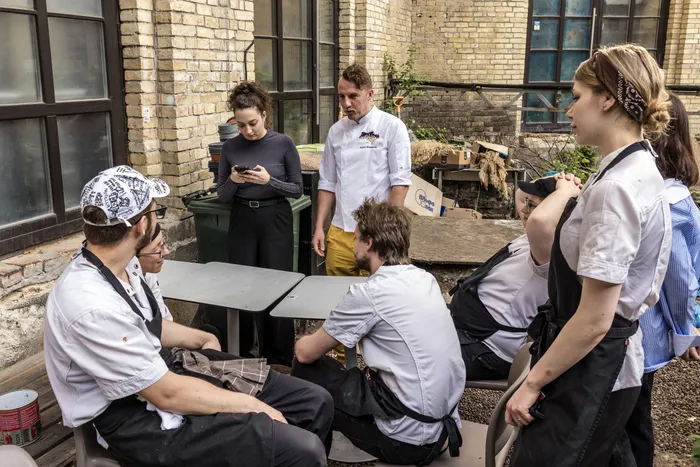
Klopotenko talks to staff at Poltava.
Image: Oksana Parafeniuk for The Washington Post
Three culinary influences
Klopotenko believes authentic Ukrainian cuisine can be divided into roughly three types: ethnic Ukrainian cuisine pre-1920s; cuisine that evolved during the U.S.S.R. regime, such as chicken Kyiv (which has a history that dates back to pre-Soviet Ukraine); and cuisine of ethnic groups such as Jews, Crimean Tatars and Hungarians. Klopotenko tells me how amazed he was to learn that knishes, stuffed savory pastries, didn’t belong to just the Poltava-based Jewish populations, but were also traditional in the Boiko cuisine from the Carpathian Highlands. Deep-fried meat-stuffed hand pies called chibereky are from the Crimean Tatars.
He references forshmak, a Yiddish word for chopped herring, because that also happens to be its Ukrainian name. His recipe is nearly identical to my mom’s, including the use of grated tart apple. He counts the Lviv cheesecake, a dish he wasn’t familiar with until he tasted American cheesecake, as another contribution from the Ukrainian Jews. Perhaps because Klopotenko has experienced cultural erasure, he is diligent in attributing the recipes to the groups who shaped Ukrainian cuisine.
I ask him: Why does he think culinary erasure was inflicted not just on Ukrainians but, at least to some extent, all former Soviet republics? This is clearly a question he has been thinking about, too. “Everyone except for Georgian food,” he says. “Is it because Stalin was Georgian?” I wonder. Armenian cuisine also had more distinction: Was that because Anastas Mikoyan, Stalin’s foreign trade minister, was Armenian?
Mikoyan’s trip to the U.S. in 1935 introduced Soviet citizens to many popular American foods, including hamburgers, ice cream, cornflakes, popcorn, tomato juice, grapefruit and corn on the cob. He also oversaw the publication of a cookbook that became the culinary bible of Soviet women, “The Book of Tasty and Healthy Food,” first published in 1939. I have inherited a copy of it from my maternal grandmother, and it’s as much a cooking manual as a historic artifact. The thesis was that everyone was to have the same cuisine and eat the same thing.
In 2017, shortly after Klopotenko first started introducing traditional Ukrainian dishes to the country, he was tasked with revamping the lunches in all public school cafeterias to be more nutritionally sound as well as to reflect the national cuisine. His first realisation was that the offerings lacked distinct flavorings and spices. When he inquired why, he was told that their use was prohibited on a government level during the Soviet era. Klopotenko theorises that using spices, especially those considered signatures of specific cuisines, would give a facet of individuality that’s dangerous to a government trying to establish hegemony. Creativity - in literature, art and cooking - was discouraged.
Klopotenko is still involved in the school lunch project, and he has been working with Ukrainian first lady Olena Zelenska’s office and a handful of nonprofits. He’s now teaching cooking instructors so the programme can scale its efforts.
‘Not all soldiers carry weapons’
If past is prologue, Russia’s invasion has made the erasure of Ukrainian culture a possibility again. Russian President Vladimir Putin has called the dissolution of the USSR the 20th century’s greatest tragedy. When I ask Klopotenko about Putin’s ambitions, he nods. The Russians, he says, want to erase Ukraine the same way the Soviets tried to.
In February 2022, Russia launched its invasion under the premise that Ukraine posed an existential threat to Russia, falsely claiming that it was under the control of a Nazi regime. Nothing about the events surprised Klopotenko. A student of history, he saw the writing on the wall: Russia’s incursion felt “inevitable.”
Creating a cookbook under normal circumstances is arduous, not least because most of them have professionally propped, styled and shot photographs. Russia’s nonstop attacks on Ukraine’s energy infrastructure made the photo shoot for Klopotenko’s cookbook that much harder. At one point, his team had to switch from induction cooking to gas. At times, they didn’t even have water.
“How do you shoot a cookbook if you don’t have electricity for heat or lighting?” Szczerban asks me on the phone, and I can picture him shaking his head incredulously. “They were trying to have a sense of normalcy in this disruptive, horrible time, and were actually able to produce something incredible.”
As the Trump administration tries to cobble together a ceasefire agreement and has recently secured a minerals deal with Ukraine, the fighting continues, with Russia continuing to bomb civilian areas such as Kyiv. Ukrainians are weary, Klopotenko acknowledges with a sad smile, but he’s resolute: Ukrainians will fight until the last man is standing. “There is no way we’ll be living with them again or have Russia tell us what to do. … As long as we exist, our culture will exist.”
Szczerban thinks of Klopotenko as a defender of Ukraine through food diplomacy. “Not all soldiers carry weapons,” he says. Food touches everything, he adds: family, economics, politics, pleasure, scarcity, conflict. “What I understood after meeting with Yevhen was that he saw that this was the fabric of a culture and wanted to share it with the world. … It’s not just about defense funding, but also about understanding what needs to be defended.”
In that mission, Klopotenko is just getting started.
“We have lots of different dishes to show to the world,” he says. “And when they say, ‘Where have you been?,’ we’ll say, ‘We were under occupation.’”
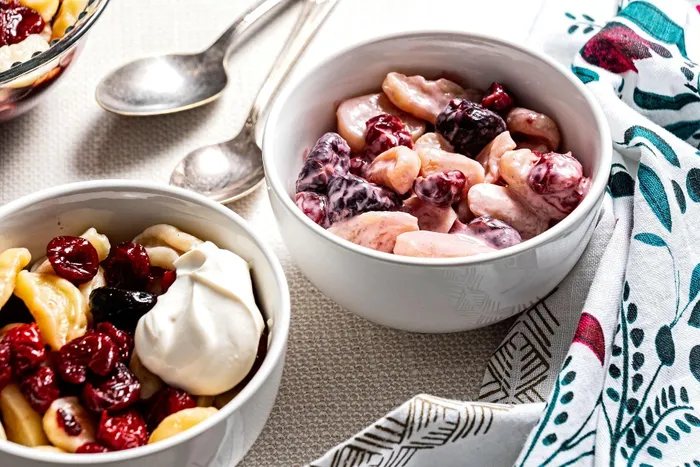
Halushky With Sour Cherries.
Image: Oksana Parafeniuk for The Washington Post
Halushky With Sour Cherries
Servings: 4-6 (makes about 6 cups dumplings)
Total time: 55 mins
Topped with a sour cherry sauce, these halushky -- Ukrainian dumplings -- come together without a lot of effort. While there are many different types of halushky in Ukraine, both filled and unfilled, these are called “schipani,” or pinched, halushky. They are created by pinching off small pieces of the dough, which are then boiled in water until they float to the top. While halushky are usually savory, Kyiv-based chef and restaurateur Yevhen Klopotenko decided to combine the dough with a sour cherry sauce for a sweet-tart side to meat, such as slow-cooked beef, or other vegetable dishes.
Make ahead: If not planning to cook the halushky right away, arrange them in a single layer on a large sheet pan and flash-freeze until firm, then transfer to a zip-top bag and keep frozen for up to 2 months. If using frozen cherries, they need to be defrosted overnight and drained before cooking. The cherry sauce can be prepared and refrigerated up to 1 week in advance.
Where to buy: Frozen sour cherries can be found year-round at well-stocked supermarkets. Fresh sour cherries can be found at farmers markets, depending on season and availability.
Ingredients
For the cherry sauce:
1 pound (454 grams) pitted sour cherries, fresh or frozen (if frozen, see Make ahead and Notes)
1/2 cup (100 grams) granulated sugar
1/8 teaspoon ground cinnamon, plus more to taste
1/8 teaspoon fine salt
For the halushky
1/2 teaspoon fine salt, plus more as needed
Scant 3 1/2 cups (425 grams) all-purpose flour, plus more as needed
Generous 1 cup (250 milliliters) well-shaken plain kefir (see Substitutions)
1 large egg
Neutral oil, such as canola or vegetable, for drizzling (optional)
Sour cream, for serving
Directions
Make the cherry sauce: In a medium (10-inch) skillet over medium-high heat, combine the cherries, sugar, cinnamon and salt, and bring to a boil, stirring occasionally to dissolve the sugar. Reduce the heat to medium and cook, stirring occasionally, until the mixture thickens slightly, 5 to 8 minutes. Taste, and add more cinnamon, if desired. Remove from the heat, cover and keep warm, or refrigerate until needed. You should have a generous 1 1/2 cups.
Make the halushky: Bring a large pot of lightly salted water to a boil over high heat. If planning to shape and freeze a portion of the halushky, line a large sheet pan with parchment paper.
Meanwhile, in a large bowl, stir together the flour and 1/2 teaspoon of the salt until combined. Add the kefir and egg, and stir with a wooden spoon until the mixture starts to become a shaggy dough. Turn out the dough onto a clean, dry countertop and knead it with your hands until tender, elastic and tacky, but not too sticky, about 5 minutes. If the dough is too sticky, add more flour, 1 tablespoon at a time, until the desired consistency is reached.
Divide the dough into 4 portions (each weighing approximately 175 grams). Working with one portion at a time - keep the remaining portions under a large bowl to prevent them from drying out - roll out into a 3/4-inch-wide rope. Use a bench scraper to cut each rope into 1/2-inch-long pieces. (If not cooking all of the halushky right away, transfer what you don’t plan to eat to the lined sheet pan, flash-freeze until firm, then divide among zip-top bags or airtight containers and keep frozen until needed.)
Working in batches as necessary to prevent overcrowding, add the dumplings to the boiling water. Allow the water to return to a boil and cook until the halushky float to the surface, about 2 minutes. Use a slotted spoon to transfer the cooked halushky to a large serving bowl and repeat with the remaining uncooked dumplings. (If the cooked dumplings are sticking to one another, lightly drizzle them with oil to keep them separated.) Ladle the cherry sauce on top. Alternatively, divide the dumplings among individual bowls and top with the cherry sauce. Serve warm, with sour cream on the side for each portion. You’ll want to mix the cherries with the sour cream until the dumplings look generously saucy.
Substitutions:
No kefir? Use buttermilk, preferably whole-fat, or plain whole-milk yogurt (not Greek).
Sour cherries. Use sweet cherries plus fresh lemon juice to achieve a sweet-tart flavor.
Adapted from “The Authentic Ukrainian Kitchen” by Yevhen Klopotenko (Voracious, 2024).